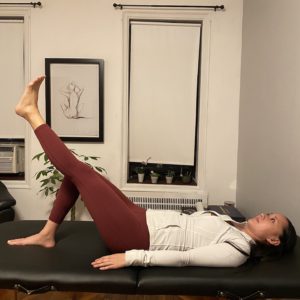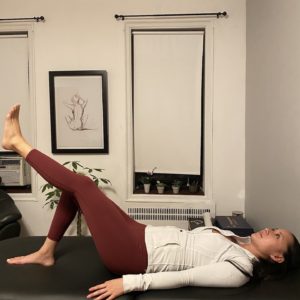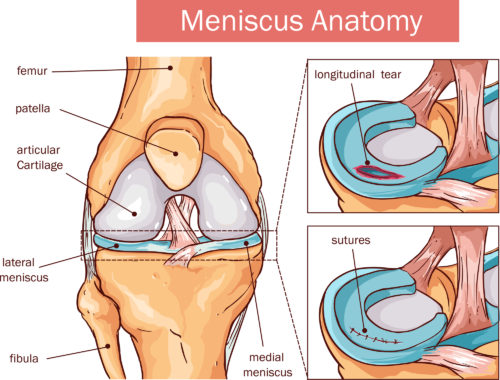What is the meniscus?
It is a C-shaped tissue that sits between your femur (thigh bone) and tibia (shin bone). We have 2 of them in each knee, called medial meniscus and lateral meniscus. The menisci cushions and absorbs any impact that goes through the knees.
The outer part of the meniscus is pretty well vascularized, meaning there is blood flow going in to the area. However, the inner portion of the meniscus is avascularized, so there isn’t much blood flow. That is why depending on how large the tear is, the meniscus may not heal. The outer portion of the meniscus can heal itself but the inner portion not so much.
How can you injure it?
You can tear your meniscus if an activity or movement causes you to forcefully twist or rotate at the knee, like when pivoting. Kneeling and deep squatting also puts a lot of pressure on the meniscus which can lead to a tear as well.
As we get older, you don’t even need a traumatic event to occur for you to injure your meniscus. That’s because of the wear and tear (degenerative changes) that happen in our knees as we age. Just like how our skin gets thinner and more wrinkly with age, our insides age too.
What are the signs I have a meniscus tear?
-Pain along the joint line
-Swelling
-Locking/catching or clicking with pain
What could have led up to my meniscus tear?
If it wasn’t a traumatic injury, limitations in ankle and hip mobility can cause a meniscus injury. Because the knee is right in between the ankle and hip, it ends up overworking and compensating for things that are not working so well in these areas.
For example, we need an adequate amount of ankle dorsiflexion when we squat. Dorsiflexion is when you lift your forefoot towards your shin, or when your shin comes down towards and past your toes like when squatting. If your knees don’t go past your toes or you can’t keep your heels grounded when you squat, you probably have limited ankle mobility. When the ankles don’t move, this puts extra stress on the knees.
Same goes for the hips. If you don’t have adequate rotation in the hips to go into a squat, your knee is going to take the brunt of it.
Forward the video to :47 to learn more about ankle dorsiflexion and how to fix it.
Should I have surgery?
As physical therapists, we always tell our patients NOT to jump into surgery, especially if it’s not a traumatic injury. Try physical therapy first. One of the main reasons being that surgery won’t fix what led to the issue in the first place. (Read the answer to the previous question).
If you have tried conservative treatment, such as physical therapy and even injections, and it is still not better, then you might be a candidate for surgery.
If you’re having surgery, here are some things to know:
You can have a meniscectomy (removal of the torn meniscus/clean up) or a meniscus repair. The goal is to save as much meniscus as possible because the less you have, the higher the chances of developing arthritis. This is something you want to speak to your surgeon about on which one is right for you.
Can I exercise with a torn meniscus?
Yes, but use pain as a guide. What is your baseline pain level? Try to rate it from 0-10. With any exercise, the baseline pain number should not increase. If it does, stop the exercise. If you feel sharp pain, stop the exercise. If your pain increases after you exercise, you might have gone too hard. RICE it and back off the next time you exercise again.
Also, early on you might want to avoid squats and lunges as this can irritate the meniscus. Try exercises that unloads the knee first, like deadlifts. Deadlifts are more of a hip dominant movement versus a squat, which is more knee dominant.
Disclaimer: Before you start any exercise program make sure you can do a proper quad set and straight leg raise first. If you cannot get a strong contraction of your quads, you really should not be doing any advanced exercises. Also, how is your range of motion? Fully bend (flexion) and straighten (extend) your knee and compare it with the other leg. If you don’t have full extension and full flexion, see a physical therapist because it is crucial you get your full range of motion back to prevent future issues.


Straight leg raise – knee is fully extended
Extension lag – unable to lock out knee

